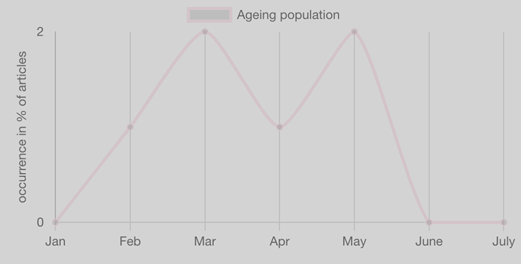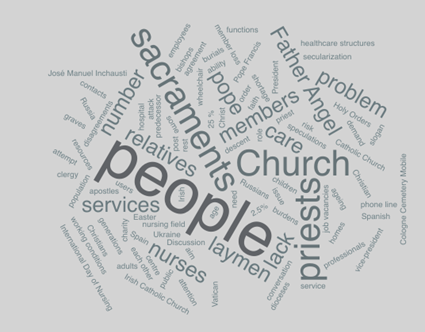Insights from the dashboard: Religion and age in demographically changing Europe
Insights from the dashboard: Religion and age in demographically changing Europe
As Europe undergoes a dramatic demographic change, what can trends in the EARS dashboard tell us about the interplay of religion and age?
The EARS dashboard is a collection of summaries from European media articles on religion and society. Between January 1 and July 30 2023, over 1,000 summaries were added to the dashboard. Of those, 8 dealt with the global development value of ageing population. The dashboard, alongside an earlier EARS article,[1] provides us with the opportunity to reach subsequent insights into how different faith institutions have been grappling with Europe’s ageing population.
Media coverage of ageing population

The above graph shows the percentage of articles on the dashboard that cover the topic of ageing population in the first half of 2023. Issues of religion and age do not regularly arise ( between 0 and 2% of articles discuss the ageing population each month) but the impact of the global development nonetheless shines through when these few articles are examined.
A recent New York Times article helps conceptualise the impact. The article noted that most, if not all, of Western Europe will have more than a quarter of its population over 65 by 2050. For some countries, that number will approach 40%.[2] This increase in the older population parallels what some of the dashboard articles reveal: religious institutions struggle to reach younger generations as their regular attendees age. Some of the struggles and attempted solutions covered in the dashboard will be explored below.
Ageing membership – new programmes and struggles with youth
The fact that religious institutions are working to adapt to an increasingly ageing population can be seen in the variety of services that they are offering to the elderly. For instance, the association of Catholic entrepreneurs (BKU) in Germany has adopted a platform aimed at curbing poverty among the elderly. The programme would have the elderly take on mini-employments to earn additional salary on top of their pensions and thereby cut back on poverty.[3]
At the same time that religious institutions are creating these programmes for the elderly, they are also looking for ways to relate with younger generations. The participation of younger generations in organised religion has significantly decreased in recent years. This drop does not necessarily reflect a lack of religiosity or spirituality but often stems from a feeling that institutions are out of touch. For instance, some dislike how institutions treat or view LGBTQ communities, others feel a disconnect because of sexual abuse scandals, while others view religions as representing opposing political values.[4]
Partnerships with secular institutions
Religious institutions are not alone in working to develop solutions and new programmes for this growing demographic shift. In Spain, for example, the insurance company MAPFRE has teamed up with the Christian charity Messengers of Peace to provide more services to the elderly. These programmes could offer newer services like the home delivery of medicines and dedicated phone lines.[5]
Similarly, both religious and governmental institutions joined in praising the work of medical professionals in Germany on International Nursing Day in May 2023. Attention on nurses was highlighted this year because of the growing number of people who require nursing care, particularly in long-term care facilities for the elderly.[6]
Ageing clergy
As the population of Europe ages and fewer young people join formal religious institutions, such institutions, particularly the Roman Catholic Church, are facing a novel issue: a lack of young clergy members. When it comes to religion and age, issues like ageing clergy are somewhat inevitable – many clergy members are appointed for life, after all. This can be seen with Pope Francis, who, at 86 years old, has generated discussions of old age following a few bouts of ill health in the past year.[7]
However, in another sense, the Catholic Church is facing a serious and unprecedented crisis in recruiting new clergy. In the Irish Catholic Church, for instance, only about 2.5% of priests are under the age of 40, generating a significant longevity problem. The recruitment has become such an issue that the church has launched a campaign to encourage younger men to join, under the slogan: ‘Take the Risk for Christ’.[8]
Similarly, an article from Belgium notes how Christian groups are trying to streamline traditional priestly activity, to make do with the smaller number of priests. In Belgium, laypeople are helping out with some of the more attainable and administrative tasks. Some have even contemplated Catholic worship without priests. Others, unwilling to embrace such a dramatic change, prefer the idea of allowing lay people to acquire special, short-term status for carrying out the sacraments, which are holy stepping stones along a Catholic’s religious life.[9]
Religious institutions as social communities

The above word cloud, taken from the dashboard, shows some of the most frequent words that appear in the articles about ageing populations and religion and age. To be expected, there are words like ‘lack’, ‘burdens’, and ‘problem’, as the changing demographics of Europe undoubtedly present several challenges to religious institutions. While perhaps simplistic, the largest word underlines one of the most fundamental – and perhaps occasionally forgotten – aspects of these institutions. At the end of the day, they are made up of and rely on people. As the makeup of Europe changes, it is virtually inevitable that so, too, will the institutions representing Europe’s faiths.
You can use the free EARS Dashboard to learn more about trends and developments on the topic of religion and society. Hundreds of article summaries from all over the world were added in the past months!
Sources
[1] How churches are failing to reach a younger audience
[2] How a Vast Demographic Shift Will Reshape the World
[3] Against poverty in old age
[4] How churches are failing to reach a younger audience
[5] Mapfre and Mensajeros de la Paz will improve care for the elderly in Spain
[7] Pope Francis is sick again






